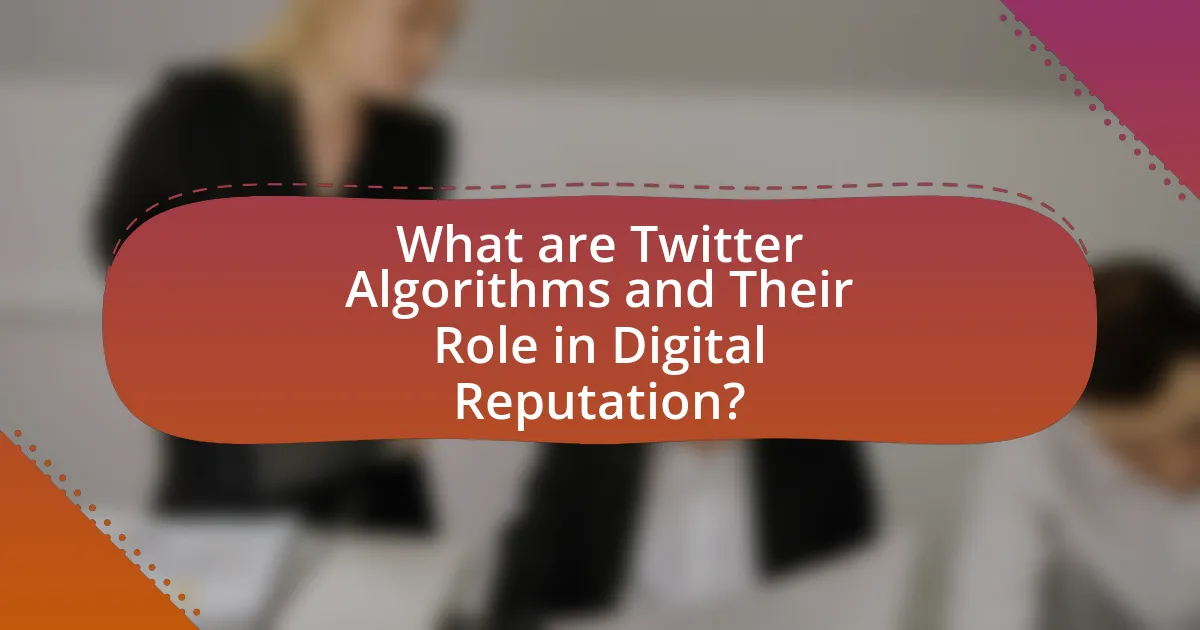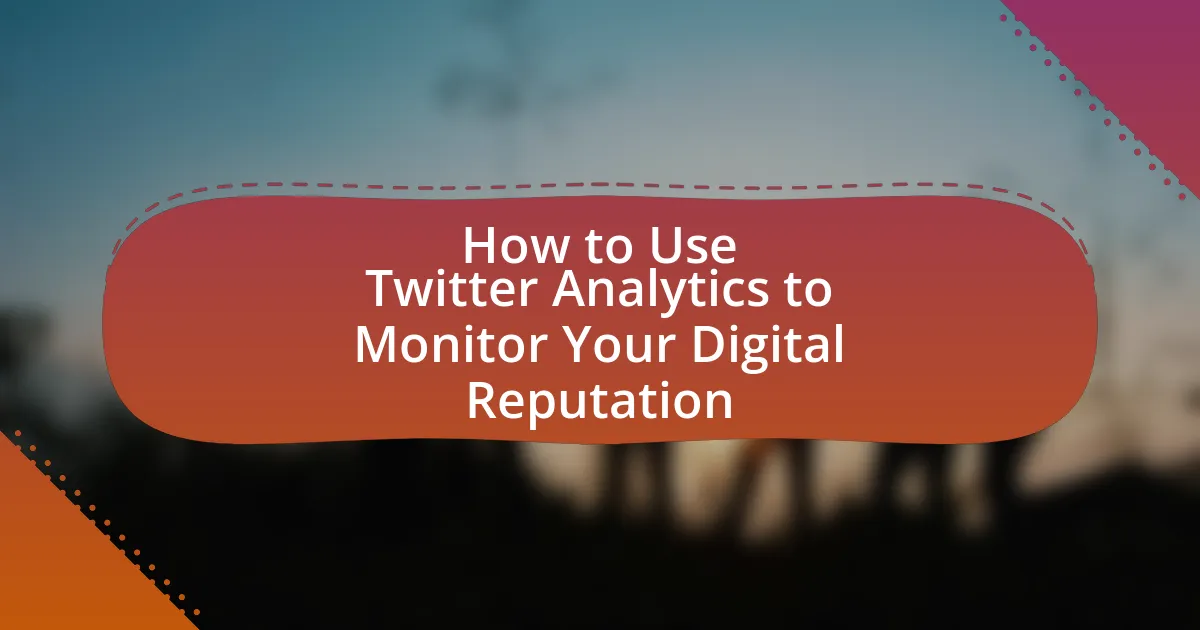Twitter algorithms are intricate systems that determine the visibility and ranking of tweets in users’ feeds, significantly influencing digital reputation. These algorithms assess user behavior, engagement metrics, and content relevance, which can either enhance or diminish a user’s perceived credibility based on interactions. The article explores how these algorithms affect user visibility, engagement, and block tracking, detailing the factors considered in content ranking and the implications for digital reputation. It also discusses the importance of maintaining a positive online image, the consequences of negative reputations, and strategies for users to navigate Twitter’s algorithm effectively. Additionally, it highlights tools and resources available for monitoring digital reputation and understanding algorithm impacts.

What are Twitter Algorithms and Their Role in Digital Reputation?
Twitter algorithms are complex sets of rules and calculations that determine the visibility and ranking of tweets in users’ feeds. These algorithms analyze user behavior, engagement metrics, and content relevance to curate personalized timelines, influencing which tweets users see and interact with. The role of these algorithms in digital reputation is significant; they can amplify or suppress content based on user interactions, thereby shaping public perception and influencing an individual’s or brand’s online reputation. For instance, tweets that receive higher engagement are more likely to be promoted, while negative interactions can lead to reduced visibility, impacting how users are perceived on the platform.
How do Twitter algorithms influence user visibility and engagement?
Twitter algorithms significantly influence user visibility and engagement by prioritizing content based on relevance and user interaction patterns. These algorithms analyze factors such as user preferences, engagement history, and trending topics to determine which tweets appear in a user’s feed. For instance, tweets from accounts that a user frequently interacts with are more likely to be shown, enhancing engagement levels. Additionally, Twitter employs machine learning techniques to refine these algorithms continuously, ensuring that the content remains aligned with user interests. This targeted approach can lead to increased visibility for certain users and content types, thereby shaping the overall engagement dynamics on the platform.
What factors do Twitter algorithms consider when ranking content?
Twitter algorithms consider several key factors when ranking content, including user engagement, recency of tweets, and the relevance of content to the user. User engagement is measured through likes, retweets, and replies, indicating how well content resonates with audiences. Recency ensures that newer tweets are prioritized, reflecting the fast-paced nature of the platform. Additionally, relevance is determined by the user’s past interactions, interests, and the accounts they follow, which helps tailor the content to individual preferences. These factors collectively enhance user experience by promoting content that is timely and engaging.
How do these factors impact a user’s digital reputation?
Twitter algorithms significantly impact a user’s digital reputation by influencing the visibility and engagement of their content. These algorithms prioritize certain types of interactions, such as likes and retweets, which can enhance or diminish a user’s perceived credibility and authority within the platform. For instance, a study by the Pew Research Center found that users with higher engagement rates are often viewed as more influential, thereby boosting their digital reputation. Additionally, the algorithms can lead to echo chambers, where users are exposed primarily to content that aligns with their views, potentially skewing public perception and affecting how others evaluate their reputation.
Why is digital reputation important in the context of social media?
Digital reputation is crucial in the context of social media because it significantly influences public perception and engagement. A positive digital reputation can enhance an individual’s or brand’s credibility, leading to increased trust and interaction from users. According to a study by the Pew Research Center, 70% of adults in the U.S. believe that online reviews and social media presence impact their purchasing decisions, highlighting the direct correlation between digital reputation and consumer behavior. Furthermore, social media algorithms often prioritize content from users or brands with favorable reputations, thereby amplifying their visibility and reach. This creates a feedback loop where a strong digital reputation leads to greater exposure, further solidifying that reputation.
What are the consequences of a negative digital reputation?
A negative digital reputation can lead to significant consequences, including loss of trust, decreased opportunities, and potential financial harm. Individuals and businesses with a tarnished online image often face skepticism from potential clients or employers, which can result in lost job offers or contracts. According to a study by CareerBuilder, 70% of employers use social media to screen candidates, and 57% of them have decided not to hire a candidate based on their online presence. Additionally, companies may experience reduced sales and customer loyalty, as 84% of consumers trust online reviews as much as personal recommendations, according to a survey by BrightLocal. Thus, a negative digital reputation can severely impact personal and professional prospects.
How can a positive digital reputation benefit users and brands?
A positive digital reputation benefits users and brands by enhancing trust and credibility. Users with a strong digital reputation are more likely to attract opportunities, such as job offers or partnerships, as they are perceived as reliable and competent. Brands with a favorable online presence experience increased customer loyalty and higher sales, as consumers tend to choose brands they trust. According to a study by Edelman, 81% of consumers need to trust a brand to buy from them, highlighting the direct correlation between reputation and consumer behavior. Thus, a positive digital reputation serves as a crucial asset for both users and brands in establishing and maintaining successful relationships.
![]()
How do Twitter Algorithms Affect Block Tracking?
Twitter algorithms influence block tracking by determining which accounts and content are visible to users, thereby affecting the interactions and visibility of blocked accounts. When a user blocks another account, the algorithm may still show content from that blocked account to others, depending on their engagement patterns and the algorithm’s prioritization of content. This can lead to situations where blocked users’ tweets appear in timelines or search results, complicating the effectiveness of blocking as a tool for managing digital reputation. Research indicates that algorithmic visibility can undermine user control over their online experience, as the algorithms prioritize engagement over user preferences, thus impacting how block tracking functions on the platform.
What is block tracking and how does it function on Twitter?
Block tracking on Twitter refers to the system that monitors and records instances when users block other accounts. This function operates by maintaining a record of blocked accounts within a user’s settings, which prevents those accounts from interacting with the user’s content. When a user blocks another account, the blocked account is unable to view the user’s tweets, follow them, or engage with their content, effectively severing the connection. This mechanism is crucial for users seeking to manage their digital reputation, as it allows them to curate their interactions and protect themselves from unwanted engagement. The effectiveness of block tracking is evidenced by Twitter’s commitment to user safety and control over their online experience, as outlined in their community guidelines.
How do Twitter algorithms impact the effectiveness of block tracking?
Twitter algorithms significantly reduce the effectiveness of block tracking by prioritizing content visibility based on user engagement rather than user preferences for blocking. These algorithms determine which tweets appear in a user’s feed, often allowing blocked accounts’ content to surface through retweets or interactions from mutual followers. Research indicates that algorithmic amplification can lead to increased exposure of unwanted content, undermining the intended purpose of blocking. For instance, a study by the Pew Research Center found that algorithm-driven feeds can expose users to content from blocked accounts, thereby complicating the user’s ability to manage their digital reputation effectively.
What are the implications of block tracking for user interactions?
Block tracking significantly impacts user interactions by limiting visibility and engagement on social media platforms. When users block others, the blocked individuals can no longer see their posts or interact with them, which can lead to a fragmented user experience. This fragmentation can result in echo chambers, where users only engage with like-minded individuals, reducing exposure to diverse perspectives. Additionally, block tracking can affect the algorithms that curate content for users, as the absence of interactions from blocked accounts may skew the algorithm’s understanding of user preferences, potentially leading to a less personalized experience. Research indicates that such dynamics can influence social relationships and information dissemination, ultimately shaping users’ digital reputations and online behavior.
How do users perceive block tracking in relation to their digital reputation?
Users perceive block tracking as a significant factor influencing their digital reputation. This perception stems from the understanding that blocking someone on social media platforms like Twitter can signal disapproval or conflict, potentially affecting how others view an individual’s credibility and social standing. Research indicates that users often associate block tracking with negative interactions, leading to concerns about being perceived as intolerant or overly sensitive. A study by the Pew Research Center found that 40% of social media users believe that blocking others can harm their reputation, highlighting the importance of managing online relationships carefully to maintain a positive digital image.
What are the psychological effects of being blocked on social media?
Being blocked on social media can lead to feelings of rejection, anxiety, and lowered self-esteem. Research indicates that social media interactions significantly impact emotional well-being; for instance, a study published in the journal “Cyberpsychology, Behavior, and Social Networking” found that individuals who experience social exclusion online often report increased feelings of loneliness and depression. The act of being blocked can trigger a sense of social isolation, as it removes the ability to communicate and engage with the person who blocked them, reinforcing negative self-perceptions and emotional distress.
How can users manage their digital reputation in light of block tracking?
Users can manage their digital reputation in light of block tracking by actively controlling their online presence and privacy settings. This includes regularly reviewing and adjusting privacy settings on social media platforms, utilizing tools that limit data tracking, and being mindful of the content they share. Research indicates that 70% of users are concerned about their online privacy, highlighting the importance of proactive measures. By understanding how algorithms work and the implications of block tracking, users can make informed decisions that protect their reputation and personal information.

What Strategies Can Users Employ to Navigate Twitter Algorithms?
Users can navigate Twitter algorithms by engaging consistently with content, utilizing hashtags strategically, and curating their follow lists. Engaging consistently means liking, retweeting, and replying to tweets, which signals to the algorithm that the user is active and interested in specific topics. Utilizing hashtags strategically allows users to increase the visibility of their tweets, as the algorithm favors content that aligns with trending topics. Curating follow lists by following accounts that align with personal interests helps tailor the user’s feed, ensuring that relevant content is prioritized by the algorithm. These strategies are effective because Twitter’s algorithm prioritizes engagement and relevance, which directly influences what content appears in a user’s timeline.
How can users optimize their content for better visibility?
Users can optimize their content for better visibility by utilizing relevant keywords, engaging visuals, and consistent posting schedules. Incorporating keywords that align with trending topics on Twitter increases the likelihood of appearing in search results and feeds, as Twitter’s algorithm favors content that resonates with current user interests. Engaging visuals, such as images and videos, enhance user interaction, which is a key factor in algorithmic promotion. Additionally, maintaining a consistent posting schedule helps build audience expectations and engagement, further boosting visibility. Research indicates that tweets with images receive 150% more retweets than those without, highlighting the importance of visual content in optimizing reach.
What types of content are favored by Twitter algorithms?
Twitter algorithms favor content that generates high engagement, such as likes, retweets, and replies. This includes trending topics, popular hashtags, and multimedia elements like images and videos, which tend to attract more interaction. Research indicates that tweets with images receive 150% more retweets than those without, highlighting the importance of visual content in driving engagement. Additionally, timely and relevant content that aligns with current events or user interests is prioritized, as it enhances user experience and keeps users engaged on the platform.
How can engagement metrics be improved to enhance digital reputation?
Engagement metrics can be improved to enhance digital reputation by increasing interaction rates through targeted content strategies. By analyzing audience preferences and behaviors, brands can tailor their messaging to resonate more effectively, leading to higher likes, shares, and comments. Research indicates that personalized content can boost engagement by up to 74%, as it aligns with user interests and encourages participation. Additionally, utilizing analytics tools to monitor engagement trends allows for real-time adjustments, ensuring that content remains relevant and impactful. This proactive approach not only fosters a positive digital reputation but also builds a loyal community around the brand.
What best practices should users follow to maintain a positive digital reputation?
To maintain a positive digital reputation, users should consistently monitor their online presence, engage respectfully on social media, and share valuable content. Monitoring involves regularly checking search results and social media profiles to identify any negative content or comments. Engaging respectfully means responding to others thoughtfully and avoiding inflammatory language, which can lead to conflicts and damage reputation. Sharing valuable content, such as informative articles or positive experiences, helps to build a constructive online image. According to a study by the Pew Research Center, 70% of employers use social media to screen candidates, highlighting the importance of a positive digital footprint.
How can users effectively respond to negative interactions?
Users can effectively respond to negative interactions by remaining calm, addressing the issue directly, and using constructive communication. Remaining calm helps to prevent escalation, while addressing the issue directly ensures that the concern is acknowledged. Constructive communication fosters a more positive dialogue and can lead to resolution. Research indicates that users who engage in respectful dialogue are more likely to improve their digital reputation, as positive interactions can counterbalance negative ones. For instance, a study by the Pew Research Center found that 70% of users who responded positively to criticism reported an improved perception from their peers.
What proactive measures can users take to build their digital reputation?
Users can build their digital reputation by consistently creating and sharing high-quality, relevant content across social media platforms. Engaging with their audience through comments, likes, and shares enhances visibility and fosters a positive image. Additionally, users should monitor their online presence by regularly searching their names and managing privacy settings to control what information is publicly accessible. Research indicates that 70% of employers use social media to screen candidates, highlighting the importance of a positive digital footprint. By actively participating in discussions and showcasing expertise in their field, users can further establish credibility and trustworthiness online.
What tools and resources are available for monitoring digital reputation on Twitter?
Tools and resources available for monitoring digital reputation on Twitter include Hootsuite, Brandwatch, and Sprout Social. Hootsuite allows users to track mentions and keywords, providing insights into public sentiment and engagement metrics. Brandwatch offers advanced analytics and sentiment analysis, enabling users to understand how their brand is perceived in real-time. Sprout Social combines social media management with analytics, helping users monitor brand mentions and audience engagement effectively. These tools are widely recognized in the industry for their capabilities in tracking and analyzing digital reputation on Twitter.
How can analytics tools assist in understanding algorithm impacts?
Analytics tools assist in understanding algorithm impacts by providing data-driven insights into user interactions and engagement metrics. These tools analyze patterns in user behavior, such as likes, retweets, and comments, which can reveal how algorithm changes affect content visibility and audience reach. For instance, a study by the Pew Research Center found that 64% of users reported that social media algorithms influenced their perceptions of news credibility, highlighting the significant role these algorithms play in shaping digital reputation. By leveraging analytics tools, organizations can quantify the effects of algorithm modifications on user engagement, allowing for informed adjustments to content strategies.
What role do third-party applications play in managing digital reputation?
Third-party applications play a crucial role in managing digital reputation by providing tools for monitoring, analyzing, and enhancing online presence. These applications aggregate data from various platforms, enabling users to track mentions, reviews, and sentiment related to their brand or personal identity. For instance, platforms like Brand24 and Hootsuite allow users to receive real-time alerts about their online mentions, facilitating timely responses to negative feedback. Additionally, these applications often offer analytics features that help users understand public perception and identify trends, which can inform reputation management strategies. The effectiveness of third-party applications is evidenced by their widespread use among businesses; according to a 2021 survey by HubSpot, 70% of marketers reported using reputation management tools to improve their brand image.
